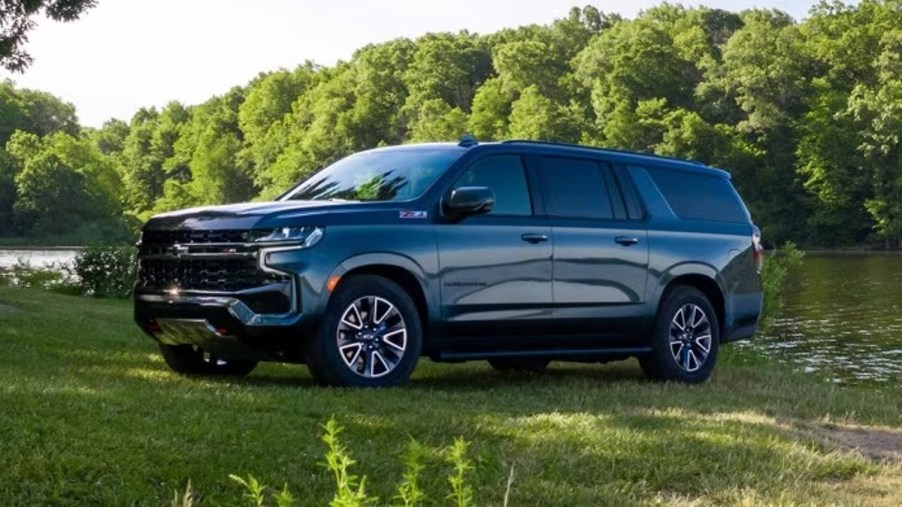
Chevy Tahoe vs. Suburban: Is There a Clear Winner?
Chevrolet makes some of the best sport utility vehicles on the market. Its Tahoe and Suburban models round out the lineup nicely in the large SUV category. Edmund’s gave these models close scores, but the Suburban came out on top. What does each large SUV offer and why did the Suburban outmatch the Tahoe? Let’s take a look.

What can you expect from the Chevy Suburban?
Powering up this 225-inch vehicle are three engine options, according to Edmund’s. Most trims offer a 5.3-liter V8 engine as standard, but the top-tier High Country model comes with a 6.2-liter V8, which produces 420 hp and 460 lb-ft of torque. Edmund’s tested the more powerful engine and got a 6.7-second acceleration time.
As an available option, there’s also a 3.0-liter Inline six-cylinder diesel, which generates 277 hp, 460 lb-ft, and offers around 24 mpg overall. The Z71 version doesn’t have this as an option, but all the other models do. Paired with all engines on all trim levels is a 10-speed automatic transmission.
Towing is not quite as good as the Tahoe, but it’s pretty close. The Chevy Suburban can haul up to 8,300 lbs when properly equipped, which is 100 lbs less than what the Tahoe can handle. Pricing ranges from $55,300 for the base all the way up to $80,100. Overall, the model received a score of 7.6 out of 10.
What Chevy’s other large SUV offers
The Chevy Tahoe has the same powertrain setup as the Suburban with a 7.7-second 0 to 60 mph acceleration time on the 5.3-liter engine (the only one Edmund’s tested). This model offers front and rear ventilated disc brakes, which can stop on a 60 to 0 mph run in 145 ft on dry surfaces and 153 ft on wet ones.
Standard features include cloth seating, an 8-way power adjustable driver’s seat, a 6-way power adjustable passenger seat, stability/traction control, 4-wheel ABS, tire pressure monitoring, LED headlights, and an engine immobilizer security system.
Pricing for this model ranges from $52,600 for the base and goes all the way up to $76,195 (before destination fees) for the top tier High-Country trim. The most popular version is the Z71, which will run you about $64,300. Available packages include a trailering package ($250), all-weather floor mats ($190), and 22-inch Chrome wheels ($3,695) to name a few. Edmund’s gave it a 7.4 out of 10.
Why the Chevy Suburban came out on top for the Large SUV category
While both SUVs are quite similar there are enough small differences between them to rank the Suburban as the #1 Large SUV in Edmund’s category and the Tahoe in the #4 spot.
The first area where the Suburban excels is its cargo storage. Having a distinct 15 inches more in length than the Tahoe, this Large SUV has 41.4 cu-ft of space behind the last row of seats. If you fold the second and third rows, you’ll get a maximum of 144.7 cu-ft of storage. The Tahoe offers a total of 122.9 cu-ft.
Both models have almost the same standard safety equipment included on the entry-level trims. The only difference is that the Suburban offers a blind spot warning accident avoidance system, whereas the Tahoe has a lane-departure warning accident avoidance system.
When it comes to fuel economy, both give the same 17 mpg combined EPA rating. However, in Edmund’s tests, the Suburban managed to squeeze out 18.7 mpg (with the 5.3-liter engine), which really impressed the reviewers for as big of a vehicle as this SUV is. The Tahoe also overachieved and gave Edmunds 17.8 mpg, which is good but it’s slightly shy of the Suburban.
Both the Chevy Tahoe and the Suburban offer plenty of features and they share quite a bit of equipment, but the Suburban has more storage capacity and can squeeze out about 1 mpg more in fuel economy, which is why it’s the #1 rated Large SUV with Edmund’s.


